| Save on your utility bills Cut and save up to 50%! Let’s try these ideas first before we buy a new furnace, windows, insulation or roof. (Photo is the famous Franklin Haunted Mansion in Cleveland. See the ghost in the window?) |
 |
Level I
“STUPID SIMPLE”
for the first 25% of savings
- To save on utility bills, you need to install a programmable thermostat and set to 63 nights and 68 days. Buy a sweater and slippers. Move the thermostat to the center location of your home. The thermostat should not be near the fireplace, window, kitchen, bathroom, exterior wall, basement, and outside wall.
 You want your thermostat in a location that has no drafts. If the thermostat is located where temperatures change frequently like near a door you will waste a ton of money. Sometimes you have to move it several times.
You want your thermostat in a location that has no drafts. If the thermostat is located where temperatures change frequently like near a door you will waste a ton of money. Sometimes you have to move it several times. - Lower hot water temperature to 110ºF. Do not worry. Your dishes and white clothes will still be clean. It’s not a perfect world. Insulate the hot water lines in the basement and crawl. Insulate the hot water tank.
- Lock all house windows. Large window gaps should be filled with removable weather putty. If windows are cracked, use the number one tool of the home “duct tape”. If your need to put plastic up on windows, do it! Install all storms if you have them. Do not leave the AC window units in windows. If they’re heavy just leave them on the floor of that room. It’s not worth hurting your back.
- Remove the high density filter, electric, or HEPA filter from your furnace. Do not tell anybody you did this because they will think you’re nuts. Filters restrict air flow which cost money. Be aware that the HAVC will no longer clean the house air. You will just have to clean your home better. Buy a HEPA vacuum cleaner.
- Turn off the furnace humidifier. (We call this a mold creating machine). These units
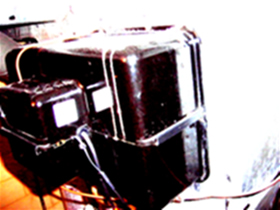 waste water and these units produce moisture. Do not use house, attic or basement exhaust fans? Well, turn on the bathroom fan when you shower. Showers should be only 3-5 minutes. Have a stop watch in the bathroom and try to beat your shower time every time you take a shower. (Right). (Photo shows a “mold creating” machine.)
waste water and these units produce moisture. Do not use house, attic or basement exhaust fans? Well, turn on the bathroom fan when you shower. Showers should be only 3-5 minutes. Have a stop watch in the bathroom and try to beat your shower time every time you take a shower. (Right). (Photo shows a “mold creating” machine.) - Install a water pressure reducer gauge on the main water supply. Set the water pressure to 50 PSI. High pressure means more flow and more flow means more bucks.
- Open window curtains on the south and west during the day. Next time buy insulated house curtains.
- Seal and insulate the attic access doors. You do not need to go to the attic this winter. In the fall, take out what you need. In spring put it back. Fiberglass insulation fibers dust, and other airborne contaminates that exist in your attic are not good for your lungs. Stay out of the non-finished attic.
- Repair all thermal by-pass locations. Example: the chimney in the basement has a 1 to 2 inch fire gap at the ceiling joist area. Air from the basement wills by-pass the first and second levels of the home to the attic. Seal this hole. Old homes are balloon structures. You need to seal these areas if they travel to the attic. Go outside and see how the snow melts on your roof. If it is irregular, go into your attic and find the holes. It may simply be that the bathroom vent is loose. Remember, warm air rises.
 Warm air will rise into your attic if you let it. Please refer to the thermal bypass section of this web site. (See the upper uneven snow melts. This is the result of thermal bypass. The home has a large attic fan on the second floor hallway. Hot air rises through this fan and into the attic. The result is heat loss and ice dams. An insulated fan box must be insulated over this ceiling whole house fan.)
Warm air will rise into your attic if you let it. Please refer to the thermal bypass section of this web site. (See the upper uneven snow melts. This is the result of thermal bypass. The home has a large attic fan on the second floor hallway. Hot air rises through this fan and into the attic. The result is heat loss and ice dams. An insulated fan box must be insulated over this ceiling whole house fan.) - Put up a sign on the front door that reads, “No Solicitors.” The sign should state “Please use side door”. Seal the door with plastic and caulk. You only have to worry about the side door. Install a new weather stripping for this side door. Just remember, every time you open the side door a dollar bill flies out.
- Reverse the ceiling fans for the winter. Make the fan blow down. Most people do not know about this fan feature. Only run the fan on very cold days.
- Shut your fireplace flues. Manufacture a Plexiglas or insulation cover. Cover the fireplace openings when not in use. Plan your fires. Remember, fireplaces are large open windows. Hot air rises. Even when your fire is roaring hot it is sucking massive amounts of air our of your home. Newton’s second law of physics state “For every action there is an equal and opposite reaction”. This means cold or moist air gets sucked back into your home from cracks, sump pumps and small openings. You will have to heat up and condition this non-conditioned infiltrating air.
LET’S KICK IT UP A NOTCH
Level II
20% more savings
- Seal up the small holes in the basement, crawl and house return ductwork. The return ducts will suck air and permit basement and crawl space depressurization. Depressurization permits cold air infiltration,
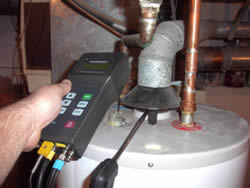 high radon, house odors, and mold. If you have a separate AC unit with ceiling registers, seal them. Hot air rises and will escape into the attic or above ceiling ductwork. Warm air in the attic space may also cause damaging ice dams. This would be considered a thermal bypass. You may need a blower door test with infrared thermography to determine where all these holes exist. Please call us in the field at 216-924-8378 to schedule a blower door and thermograpic inspection.
high radon, house odors, and mold. If you have a separate AC unit with ceiling registers, seal them. Hot air rises and will escape into the attic or above ceiling ductwork. Warm air in the attic space may also cause damaging ice dams. This would be considered a thermal bypass. You may need a blower door test with infrared thermography to determine where all these holes exist. Please call us in the field at 216-924-8378 to schedule a blower door and thermograpic inspection. - Perform full combustion analysis on all your gas fired systems. If the fossil fuel system is under-fired or over-fired, they are wasting money. It is sad that over ninety percent of HVAC service men that do residential furnace tune-ups are clueless. If a furnace man comes to your home and does not have a combustion analyzer, tell them to leave. For more information please go to our Carbon Monoxide section of this web site.(Photo shows Marko performing a combustion analysis)
- Install insulated outlet and switch covers. You can buy these products at most hardware stores.
- Pull up carpets and caulk perimeter walls. When caulking is complete call a carpet installer. A carpet installer can re-stretch your carpets for under $200.
- Seal your sump pump cover 100%. Moist air is lighter than dry air. Moist air rises. We do not need moist air in our homes. Moist air causes condensation and mold. Please refer to our sump pump section of this web site. (The photo has nothing to do with this web page section. It’s just Marko banging his head.)
- If you have a non-condensing de-humdifier, I recommend turning it off. Some people call this unit a
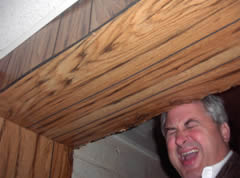 “fan in the box”. This contraption is simply a metal duct with a soundless fan that sucks conditioned air out of your home. These units are probably manufactured by nine and ten year olds in some third world country for $50. These units suck the heated dry air you paid for right out of your basement. Remember, “For every action there is an opposite and equal reaction”. This means if you suck the paid-for heated air out of your basement, new air must be replaced. Unfortunately, the new air is cold, unconditioned air that will cost you money to heat up again. These units can contribute to depressurization which could cause down drafting of gas fired systems. Carbon monoxide, odors, moisture, and mold can result when you have basement depressurization. Buy a regular de-humidifier. You cannot build a better mouse trap.
“fan in the box”. This contraption is simply a metal duct with a soundless fan that sucks conditioned air out of your home. These units are probably manufactured by nine and ten year olds in some third world country for $50. These units suck the heated dry air you paid for right out of your basement. Remember, “For every action there is an opposite and equal reaction”. This means if you suck the paid-for heated air out of your basement, new air must be replaced. Unfortunately, the new air is cold, unconditioned air that will cost you money to heat up again. These units can contribute to depressurization which could cause down drafting of gas fired systems. Carbon monoxide, odors, moisture, and mold can result when you have basement depressurization. Buy a regular de-humidifier. You cannot build a better mouse trap.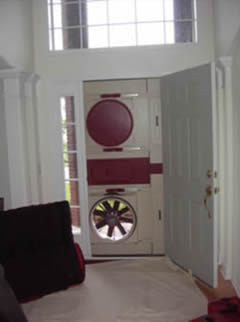
- Seal up the exterior crawl space vents. Insulate the crawl space exterior walls. Partially heat and dehumidify the crawl space. Crawl space venting is old school. In cold weather climates, crawl spaces should be conditioned. (We are from Cleveland and our web sites information is primarily for cold weather climate homes.)
- Seal up the ceiling joist cavities in all the attic areas. These are thermal bypass areas. Seal up the chimney chase, plumbing stacks, ducts, and other floor penetration in the basement and attic. Make sure you use a fireproof rated material. Seal up all basement band joist pockets. This is the upper exterior basement wall areas. It looks like a small pocket or shelf. Insulate these band joists areas with non- vapor barrier insulation. Using foil faced insulation may permit condensation. (Photo shows a blower door test. Blower door tests will find all the holes. Call Marko at 216-924-8378 to set up an inspection.)
- Ceiling can lights are major heat losers. They cause ice dams too. Replace can lights with new can lights that have less heat loss. Buy low watt or high efficiency light bulbs. Do not leave lights on. Forget about exterior holiday lights.
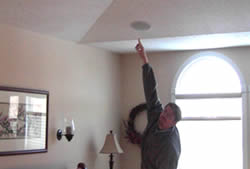

See the heat loss due to the missing insulation near the speaker. Infrared shows the speaker and missing insulation. - Adjust the temperature settings on your refrigerator and freezer for winter. Get rid of the freezer and second refrigerator. You do not need them.
- Clean the dryer vent with a leaf blower. I have actually never done this. I heard it works. The dryer vent should not be more than twenty five feet long minus 5 feet for each 90 degrees and minus 2.5 feet for each 45 degrees. You may need to install a dryer vent booster.
- Set your dishwater to air dry only.
- Seal up the third floor if it is not being used. Do not seal up rooms on main house levels. This may permit condensation and mold growth.
- Turn down dampers slightly in rooms that are not being used. Be careful when you do this, you may cause condensation. To offset cold room condensation, you need to lower the dew point. Lowering the dew point requires increasing temperature and decreasing humidity. If you are closing dampers, you won’t be increasing the temperature. So turn on a basement condensing de-humidifier. The de-humidifier requires energy to remove water. For every action there is an equal and opposite reaction. The reaction is heat produced by the de-humidifier. This is a good thing not to mention moisture removal. (The “energy people” push humidity as a cost savings method. “Moist air feels warmer” These are the same people who hook up dryer vents in attics, crawl spaces and garages. They do not understand building science and psychometrics. We are building scientists with the building science approach. We do not like condensation within our walls.)
- During the winter, shut down the third floor, wing, sun room, Florida room, green house, or other similar type room.
- Do not use the AC. On the hottest summer days. Go somewhere. Malls and libraries are very cool on hot days. Read a book in the mall or library.
FOR THE LAST 5% OF SAVINGS

The information below is for your “entertainment”.
- Drop the thermostat night temperature to 60ºF and day temperature to 65ºF. You will need blankets for evening television.
- On the weekends, turn heat down to 55ºF and visit in-laws.
- Invite your friends over in spring and fall when the heat and AC are off. Now they have to invite you over when heat or AC is needed. When you visit them, turn down your heat.
- Eat cold meals. If you have to cook, make meals for the whole week. After you’re done cooking, leave the oven door open.
- Send your children to play at others peoples home or to grandmas for the weekend. If you want to warm up, go to the mall. In the summer during a hot day, go shopping or visit your friend’s homes that have AC. Turn yours off.
- Do not run the water when you’re shaving or brushing your teeth. Put weights in the toilets back tank. Turn your water pressure down to a 30 PSI.
- Exercise in your living room daily. Perspiration will slightly increase temperature and humidity.
- Get rid of all your house stuff including unused furniture. It takes energy to heat and cool this stuff. Remember all your stuff absorbs energy. You paid for this energy.
- Paint your house black. Black absorbs energy from the sun. Let the sun help heat your home in the winter.
- Turn off your refrigerator for December, January, and February. Put the freezer items on your back porch. Put the other food in a cold non-heated basement room.
- Tell your in-laws and friends that your washing machine and dryer are broken. Use theirs.
- Several times a week go eat at a free soup kitchen. Do not worry, nobody will know you.
- Eat beans. They make you fart. Farts are small heated air bubbles.
To Save On Your Utility Bills, Call Marko Vovk
216-924-TEST